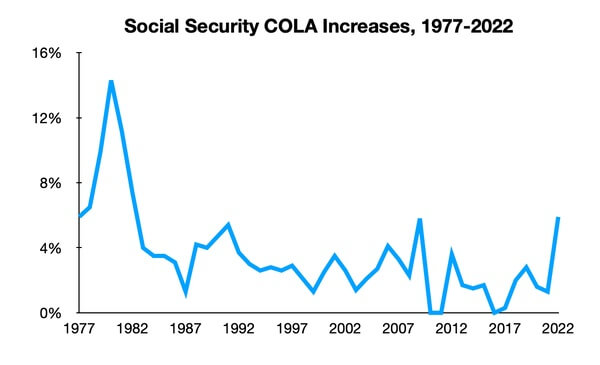Social Security announced a benefits increase of 5.9% on October 13, 2021. This Cost-of-Living-Adjustment (COLA) will increase payments to both Social Security beneficiaries (typically retirees) and people on Supplemental Security Income (SSI). The increase will be applied beginning with beneficiaries’ January 2022 checks.
Historical COLA Increases
A 5.9% increase is the largest increase to Social Security benefits in decades. You have to go back almost 40 years to find a larger annual increase when the COLA increased by 7.4% in 1983. The next closest COLA increase more recently was at 5.8% in 2009.
COLA Calculation
The annual increase calculation is based on the Consumer Price Index for Urban Wage Earners and Clerical Workers (CPI-W). Just from the name of the index, you can deduce that there is a problem with this calculation method. The vast majority of Social Security recipients are not currently “wage earners”; they are retirees. In addition, many retirees do not live in urban areas.

The cost of health care for retirees has increased dramatically more than average of the CPI-W of 2% since 2000. There have been several attempts to correct this mismatch, including the recently introduced Safeguarding American Families and Expanding Social Security Act of 2021 (SAFE Social Security Act). This legislation proposes to use the Consumer Price Index for the Elderly (CPI-E). Using the CPI-E versus the CPI-W would have increased annual social Security COLAs by approximately 0.2% in recent years. We will keep an eye on new legislation and update this post if any changes are made in the calculation.
Medicare Part B Changes
Medicare Part B and D payments are often paid out of beneficiaries’ monthly checks. For 2021 the standard Part B payment was $148.50. Several sources have estimated that the standard Part B payment for 2022 will increase by $10.00 to $158.50.
The estimates for Medicare Part B were significantly too low. The Part B premium increase for 2022 is $21.60 (a 14.5% increase). This will raise the standard monthly premium from $148.50 to $170.10.
Additionally, Medicare Part B and D payments are based on your modified adjusted gross income (MAGI) as reported on your tax return two years ago. As your income increases, the Part B and D payments increase by an Income Related Adjustment Amount (IRMAA). This increase can be quite significant, as you can see on Part B costs Medicare and Part D premiums. For 2022, each of the adjustment amounts increased by approximately 14%.
How to Estimate Your 2022 Social Security Increase
If you are paying your Medicare Parts B and D out of your monthly Social Security check, add back the amount you are paying for Parts B and D. In addition, you need to add back any tax withholding that is being deducted from your monthly benefit. This gives you your unadjusted 2021 Social Security benefit amount.
Multiply your 2021 Social Security benefit amount by 1.059 to estimate your unadjusted 2022 Social Security benefit amount.
Subtract your Parts B and D, and any tax withholding from your 2022 Social Security benefit amount. The result should be a good estimate of the amount you will begin receiving in your January 2022 deposit.
This estimate does not include the complex rounding formula Social Security uses to reduce benefits for retirees. If you want to get a more accurate estimate, you can apply the rounding rules located at Social Security Program Operations Manual System (POMS).
If you have any questions concerning your Social Security benefit amount, please email us at [email protected].

Leave a Reply